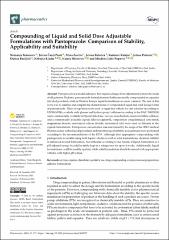Compounding of Liquid and Solid Dose Adjustable Formulations with Pantoprazole: Comparison of Stability, Applicability and Suitability

View/
Date
2023Author
Todorović, Nemanja
Čanji Panić, Jelena
Zavišić, Mina
Krtolica, Jelena
Ratajac, Radomir
Petrović, Jelena
Bosiljčić, Dušica
Kladar, Nebojša
Milošević, Nataša
Lalić-Popović, Mladena
Metadata
Show full item recordAbstract
Pantoprazole is a model substance that requires dosage form adjustments to meet the needs
of all patients. Pediatric pantoprazole formulations in Serbia are mostly compounded as capsules
(divided powders), while in Western Europe liquid formulations are more common. The aim of this
work was to examine and compare the characteristics of compounded liquid and solid dosage forms
of pantoprazole. Three syrup bases were used: a sugar-free vehicle for oral solution (according to
USP43-NF38), a vehicle with glucose and hydroxypropyl cellulose (according to the DAC/NRF2018)
and a commercially available SyrSpend Alka base. Lactose monohydrate, microcrystalline cellulose
and a commercially available capsule filler (excipient II, composition: pregelatinized corn starch,
magnesium stearate, micronized silicon dioxide, micronized talc) were used as diluents in the
capsule formulations. Pantoprazole concentration was determined by the usage of the HPLC method.
Pharmaceutical technological procedures and microbiological stability measurements were performed
according to the recommendations of the EP10. Although dose appropriate compounding with
pantoprazole is suitable using both liquid vehicles as well as solid formulations, chemical stability
is enhanced in solid formulation. Nevertheless, according to our results, if liquid formulation is a
pH adjusted syrup, it could be safely kept in a refrigerator for up to 4 weeks. Additionally, liquid
formulations could be readily applied, while solid formulation should be mixed with appropriate
vehicles with higher pH values.
